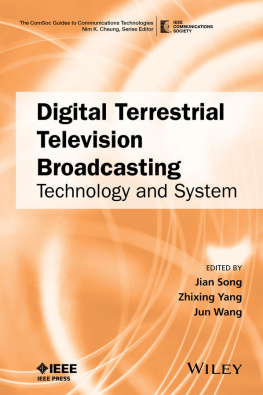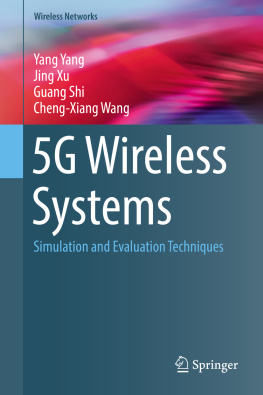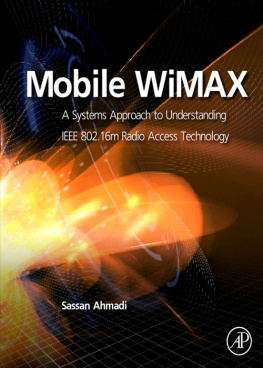CONTENTS
List of Tables
List of Illustrations
Guide
Pages
IEEE Press
445 Hoes Lane
Piscataway, NJ 08854
IEEE Press Editorial Board
Tariq Samad, Editor in Chief
| George W. Arnold | Vladimir Lumelsky | Linda Shafer |
| Dmitry Goldgof | Pui-In Mak | Zidong Wang |
| Ekram Hossain | Jeffrey Nanzer | MengChu Zhou |
| Mary Lanzerotti | Ray Perez | George Zobrist |
Kenneth Moore, Director of IEEE Book and Information Services (BIS)
Technical Reviewers
Xinyi Liu, Hong Kong Applied Science and Research Institute
Pablo Angueira, University of the Basque Country
Digital Terrestrial Television Broadcasting
Technology and System
Edited by
Jian Song
Zhixing Yang
Jun Wang
Copyright 2015 by The Institute of Electrical and Electronics Engineers, Inc.
Published by John Wiley & Sons, Inc., Hoboken, New Jersey. All rights reserved
Published simultaneously in Canada
No part of this publication may be reproduced, stored in a retrieval system, or transmitted in any form or by any means, electronic, mechanical, photocopying, recording, scanning, or otherwise, except as permitted under Section 107 or 108 of the 1976 United States Copyright Act, without either the prior written permission of the Publisher, or authorization through payment of the appropriate per-copy fee to the Copyright Clearance Center, Inc., 222 Rosewood Drive, Danvers, MA 01923, (978) 7508400, fax (978) 7504470, or on the web at www.copyright.com. Requests to the Publisher for permission should be addressed to the Permissions Department, John Wiley & Sons, Inc., 111 River Street, Hoboken, NJ 07030, (201) 7486011, fax (201) 7486008, or online at http://www.wiley.com/go/permission.
Limit of Liability/Disclaimer of Warranty: While the publisher and author have used their best efforts in preparing this book, they make no representations or warranties with respect to the accuracy or completeness of the contents of this book and specifically disclaim any implied warranties of merchantability or fitness for a particular purpose. No warranty may be created or extended by sales representatives or written sales materials. The advice and strategies contained herein may not be suitable for your situation. You should consult with a professional where appropriate. Neither the publisher nor author shall be liable for any loss of profit or any other commercial damages, including but not limited to special, incidental, consequential, or other damages.
For general information on our other products and services or for technical support, please contact our Customer Care Department within the United States at (800) 7622974, outside the United States at (317) 5723993 or fax (317) 5724002.
Wiley also publishes its books in a variety of electronic formats. Some content that appears in print may not be available in electronic formats. For more information about Wiley products, visit our web site at www.wiley.com.
Library of Congress Cataloging-in-Publication Data is available.
ISBN: 978-1-118-13053-7
Preface
The goal of this book is to serve as a comprehensive reference book for readers in the field of electronic engineering with a background in digital signal processing and telecommunications (only fundamentals and not necessarily with advanced knowledge in this area). The target readers include researchers, engineers, service providers, market analyst, policy makers, and IT staff who work in the digital video broadcasting area. The book may serve as a textbook for undergraduate courses of one semester or short courses if the instructor only focuses on the fundamental concepts and as a graduate textbook if details need to be addressed. It can also serve as a continuing education textbook for those in the DTV industry who want to obtain the latest updates.
describes the technical features in detail of four multimedia mobile broadcasting systems. Even though some systems are out of favor nowadays due mainly to the spectrum issue and the tough competition, the featured technologies of those systems have been adopted by other systems.
With 10 chapters and quite broad topics, the instructor may arrange the topics in different ways depending on the time length of the course. provides a good topic for continuing education purposes.
The authors of this book have actively been involved with fundamental research on the core technologies of DTTB systems (i.e., time-domain synchronous OFDM, TDS-OFDM), hardware implementation and the performance validation of the DTTB receiver (more specifically, the DTMB receiver), and the international standardization process, and some technical context directly comes from their research and development work. This valuable experience has motivated the authors to write this book and share their research results and comprehensive understanding of the DTTB system with readers who work in this area.
The authors would like to express their sincere appreciation for the contributions of Dr. Nim Cheung. Without his kind recommendation, encouragement, and always on-time help, this book would not have been completed. The book is a joint effort of researchers working at Tsinghua University, China. The authors are indebted to Professor Jintao Wang, Professor Chao Zhang, Professor Changyong Pan, Professor Zhaocheng Wang, Professor Fang Yang, Professor Yonglin Xue, Professor Kewu Peng, Professor Yu Zhang, Professor Hui Yang, Dr. Qiuliang Xie, and other team members for their much valuable contributions.
The authors would also like to thank all the comments from the reviewers of this book proposal as well as this book. Their much valuable comments and suggestions allowed us to better choose and arrange all the context of the book. Finally, we also thank the great help and patience from Mary Hatcher and Brady Chin of John Wiley & Sons, Inc. Without their kind guidance and assistance, it would have taken much longer with more painful effort to finish the book.
Basic Concepts of Digital Terrestrial Television Transmission System
1.1 Introduction and Historic Review
Television is a word of Latin and Greek origin meaning far sight. In Greek, tele means far while visio is sight in Latin. A television (TV) system transmits both audio and video signals to millions of households through electromagnetic waves and is one of the most important means of entertainment as well as information access. With the never-ending technological breakthroughs and the continuously increasing demands of audio and video services, the TV system has evolved over generations with several important developmental periods in less than a century.
1.1.1 Birth and Development of Television Black-and-White TV Era
In the mid-1920s, the Scottish inventor John Logie Baird demonstrated the successful transmission of motion images produced by a scanning disk with the resolution of 30 lines, good enough to discern a human face. In 1928, the first TV signal transmission was carried out in Schenectady, New York, and the world's first TV station was established by the British Broadcasting Corporation in London eight years later. After World War II, the black-and-white TV era began. Detailed technical and implementation specifications of TV service, including photography, editing, production, broadcasting, transmission, reception, and networking, were gradually formulated. With the ever-growing popularity of TV viewers, the color TV with better watching experience was invented to simulate the real world.












